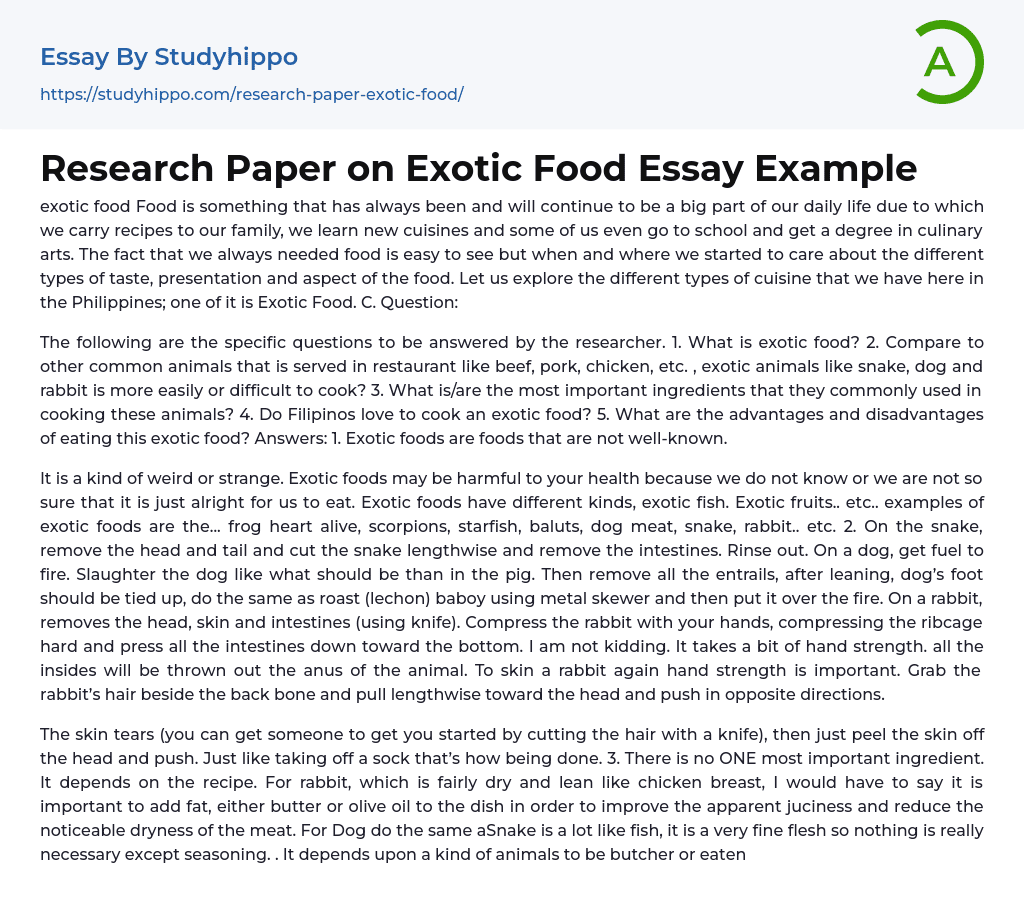exotic food Food is something that has always been and will continue to be a big part of our daily life due to which we carry recipes to our family, we learn new cuisines and some of us even go to school and get a degree in culinary arts. The fact that we always needed food is easy to see but when and where we started to care about the different types of taste, presentation and aspect of the food. Let us explore the different types of cuisine that we have here in the Philippines; one of it is Exotic Food. C. Question:
The following are the specific questions to be answered by the researcher. 1. What is exotic food? 2. Compare to other common animals that is served in restaurant like beef, pork, chicken, etc. , exotic animals
...like snake, dog and rabbit is more easily or difficult to cook? 3. What is/are the most important ingredients that they commonly used in cooking these animals? 4. Do Filipinos love to cook an exotic food? 5. What are the advantages and disadvantages of eating this exotic food? Answers: 1. Exotic foods are foods that are not well-known.
It is a kind of weird or strange. Exotic foods may be harmful to your health because we do not know or we are not so sure that it is just alright for us to eat. Exotic foods have different kinds, exotic fish. Exotic fruits.. etc.. examples of exotic foods are the... frog heart alive, scorpions, starfish, baluts, dog meat, snake, rabbit.. etc. 2. On the snake, remove the head and tail and cut the snake lengthwis
and remove the intestines. Rinse out. On a dog, get fuel to fire. Slaughter the dog like what should be than in the pig. Then remove all the entrails, after leaning, dog’s foot should be tied up, do the same as roast (lechon) baboy using metal skewer and then put it over the fire. On a rabbit, removes the head, skin and intestines (using knife). Compress the rabbit with your hands, compressing the ribcage hard and press all the intestines down toward the bottom. I am not kidding. It takes a bit of hand strength. all the insides will be thrown out the anus of the animal. To skin a rabbit again hand strength is important. Grab the rabbit’s hair beside the back bone and pull lengthwise toward the head and push in opposite directions.
The skin tears (you can get someone to get you started by cutting the hair with a knife), then just peel the skin off the head and push. Just like taking off a sock that’s how being done. 3. There is no ONE most important ingredient. It depends on the recipe. For rabbit, which is fairly dry and lean like chicken breast, I would have to say it is important to add fat, either butter or olive oil to the dish in order to improve the apparent juciness and reduce the noticeable dryness of the meat. For Dog do the same aSnake is a lot like fish, it is a very fine flesh so nothing is really necessary except seasoning. . It depends upon a kind of animals to be butcher or eaten with stomachs of steel and a hearty
appetite for food, the rural Filipino sees all animals, no matter how frightening, as opportunities to create a delicious bite, whether it's a meal, a snack, or even just an appetizer to go with their beer and gin. We have no doubts about cooking, and eating pretty much anything that moves: dogs, snake, bats, field rats, frogs and so much more. Which is why in the Filipino kitchen, nothing is ever wasted. Every bit of the animal is used. A pig, for example, offers a cook more possibilities beyond pork chops.
Its blood, ears, intestines, cheeks, and tail are used as a matter of course - exactly - for various specialty Filipino dishes. This creativity and resourcefulness in cooking and consuming the exotic is motivated by hunger and survival as well as the enjoyment and thrill of eating the unusual. 5. There are no great advantages. One disadvantage is the availability and cost. Sources for the inspected meat are difficult to find and they are relatively expensive to the more readily available meats in the market. They are relatively healthy, although to make them palatable to the average pallate, you need to add fat still.
- Food Safety essays
- Food Security essays
- Beverages essays
- Cuisines essays
- Dairy essays
- Desserts essays
- Fast Food essays
- Bread essays
- Meal essays
- Meat essays
- Organic Food essays
- Rice essays
- Sugar essays
- Taste essays
- Beef essays
- Coconut essays
- Crowd essays
- Dinner essays
- Juice essays
- Sainsbury essays
- Cooking essays
- Ginger essays
- Oreo essays
- Drink essays
- Beer essays
- Wine essays
- Coffee essays
- Tea essays
- Cake essays
- Hamburger essays
- Ice Cream essays
- Burger essays
- Pizza essays
- Fruit essays
- Lemon essays
- Food Waste essays
- Favorite Food essays
- Alcoholic essays
- Soft Drinks essays
- Cookie essays
- Starch essays
- Yeast essays
- Cola essays
- Pizza Hut essays
- snack foods essays
- chips essays
- Biscuit essays
- Brewing essays
- Brewery essays
- Anorexia essays




